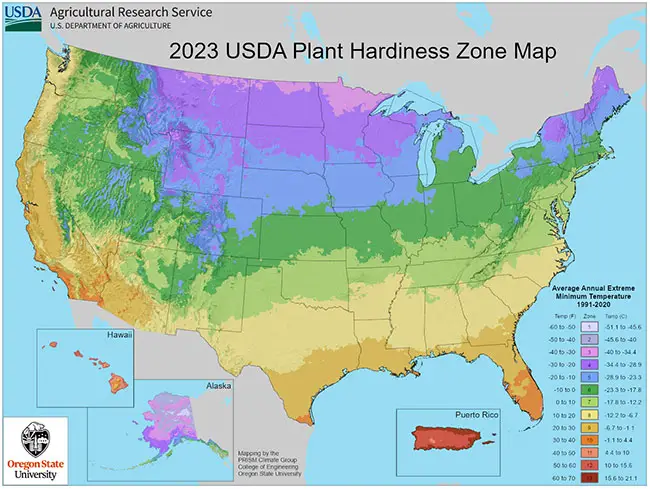
This map was created by the U.S. Department of Agriculture (USDA) Agricultural Research Service (ARS) which has recently (2012) completed an extensive updating of U.S. Hardiness Zones based upon data from 5,000 National Climatic Data Center cooperative stations across the continental United States.
The USDA Hardiness Zone Map is a map with regions defined by a 10-degree Fahrenheit difference in the average annual minimum temperature. This map divides North America into 11 separate zones. The higher the zone number, the warmer the area.
Information from the zone map helps gardeners to compare their garden climates and determine what plants will grow in their area.
Keep in mind, that this map only shows average annual minimum temperatures and doesn’t take into consideration essential factors like soil types, rainfall, daytime temperatures, day length, wind, humidity, and heat.
Knowing your hardiness zone is just not enough. A good example would be Portland, OR, and Austin, TX. Even though they are both located in Zone 8, their climates are dramatically different.
Palm Trees by State
Find out what palm trees can grow in your state:
Applying Zone References
In a palm profile, you may have noticed references to a specific zone or a range of zones. When a palm is labeled as hardy to zone 7, it means it can endure the lowest temperatures typical for that zone.
If a range of zones is provided, such as 7-10, it signifies that the palm can thrive only within that specified range of zones and won’t tolerate colder or warmer temperatures.
Microclimate
If you happen to reside in a microclimate, which refers to an area with a climate slightly distinct from the general climate of the region, you may find that you can cultivate more or fewer palm varieties in your garden.
Even within a city or on a single street, there might be microclimates influenced by factors like sun exposure or protection from warm walls in your garden. These microclimates can significantly influence how plants, including palms, grow.
USDA Zones
Here is a list of zones with average annual low temperatures:
- Zone 1: below -50 F (below -46 C)
- Zone 2: -50 to -40 F (-46 to -40 C)
- Zone 3: -40 to -30 F (-40 to -34 C)
- Zone 4: -30 to -20 F (-34 to -29 C)
- Zone 5: -20 to -10 F (-29 to -23 C)
- Zone 6: -10 to 0 F (-23 to -18 C)
- Zone 7: 0 to 10 F (-18 to -12 C)
- Zone 8: 10 to 20 F (-12 to -7 C)
- Zone 9: 20 to 30 F (-7 to -1 C)
- Zone 10: 30 to 40 F (-1 to 4 C)
- Zone 11: above 40 F (above 4 C)
Related articles:
- How to Save Cold-Damaged Palm Tree
- Top 10 Cold Hardy Palms
- Importance of Microclimate When Choosing Cold Hardy Palms
- Top 5 Factors Affecting Cold Hardy Palm Tree Growth

Thank you for this great information. We moved from central Florida to north central Florida. Our cardboard palm has gotten way to big to leave on the patio near the pool. We have had this plant for over 15 years. It’s time to put it in the dirt. I was concerned about the colder winters here 7 miles south of the Georgia border. Now we know how to take care of the “not palm” during cold snaps he is going outside, in the ground, in a wind protected area. And I’ll be using Christmas lights to keep him nice and toasty warm. Thank you Katrin.
Karen Stone
I live in joplin since1994 I have grown needle palms 9′ x 6′
Saban minor 7′
Tracy nana 2′
All 3 in the open , to grace driveways and on the east and south side.
I call the sabals on the west side with no protection the “ice palms”
What would your recommendation be for a thin, smooth trunked palm that would be tolerant of Zone 8 in Austin, TX?
Thanks,
Pat
Hi Katrin, my name is Gary. My question is what type of grow light to use for a Queen Palm that I had to bring indoors from the cold unpredictable winter weather here in the northeast? I like your informative site. I’m not a Twitter guy, l work 6pm-4:30am.
where can we find the list and photo’s of palm trees that fit in our space and grow a bit slow (so that they will continue to fit?
We are wanting to fit palm trees between a 4 wide and 5 ft wide (between a screened room and fence.
I have tested many cold hardy palms at my moms house for 5 years and I came into a conclusion. I noticed. Needles palms and windmills and most sabal palms do great in Indiana zone 6a. Everything else needs heavy protection. Since I have my own house am going to start working on the landscaping as well. I love Arizona Fan palm. I know they need heavy protection and I have seeds for it so am sure I could get them to work here as well. It’s all about trial and error.